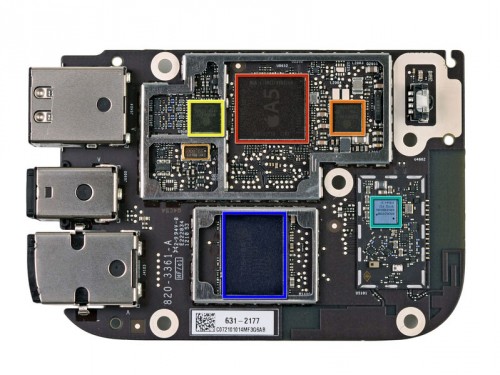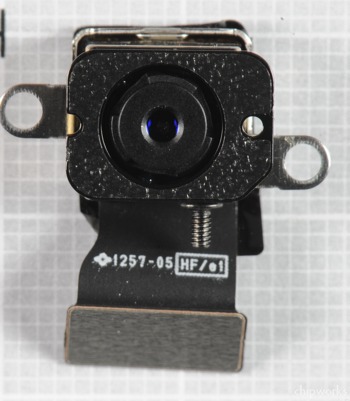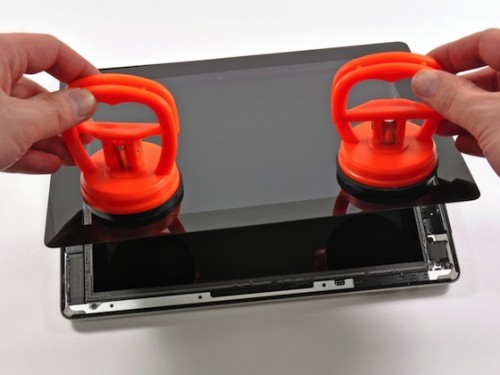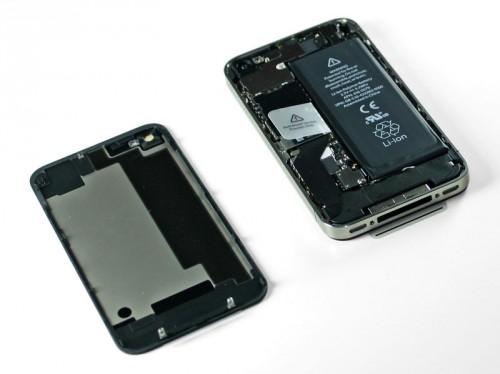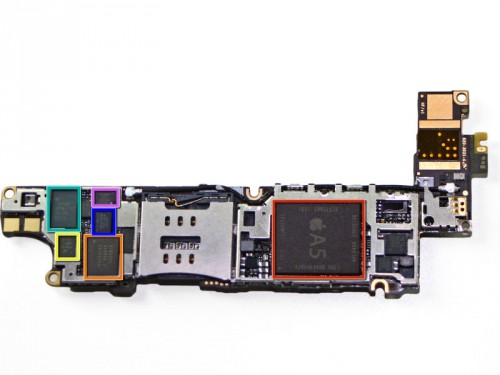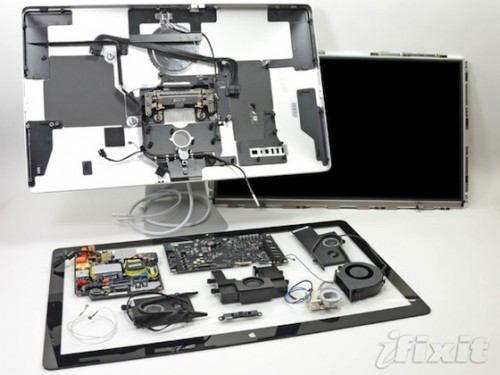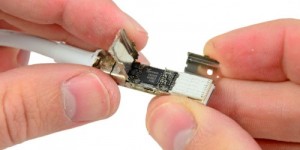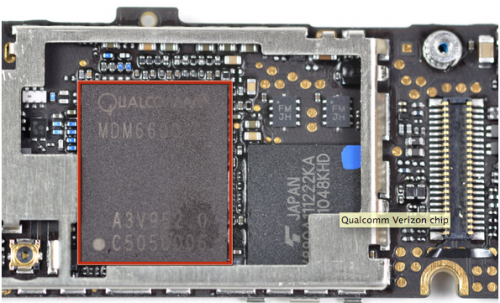News tagged ‘iFixit’
Teardown of new 1080p Apple TV finds cooler single-core A5 CPU
On Monday iFixit also get their hand on the recently released Apple TV. Having disassembled the device, the team found that this version of Apple’s set-top box does not have a thermal pad, suggesting it runs even cooler than its predecessor.
Even though it apparently runs cooler, the new CPU is more capable and allows users to output 1080p high-definition video content. The device still has the same power supply, though, providing 3.4V at 1.57A.
An earlier disassembly of the new Apple TV discovered that the updated set-top box features the same 8 gigabytes of storage as its predecessor. Monday's latest peek inside the Apple TV also found two antennae inside the device. The addition is presumed to boost signal strength in the latest Apple TV.
iPad 3 Utilizing Same Camera Sensor Found In Older Apple’s Devices
Following the iFixit’s dismantiling of an iPad 3, Chipworks has the results of its own new iPad teardown. The most interesting discovery is that Apple has seemingly reused cameras from its prior devices for both the rear and front cameras of the iPad 3. The rear camera that is shown above seems to be the 5 MP CMOS Image Sensor the company used in the iPhone 4.
Teardown of New iPad Reveals Samsung Retina Display
Fixit prefers not to waste time and already got their hands on the new iPad. To disassemble the recently released Apple’s tablet, the teardown experts travelled to Australia where it is officially on sale.
The front panel of the new iPad was removed by using heat, guitar picks as an opening tool, and suction cups. The teardown offers the first conformation of multiply rumours that circulated ahead the release of the new iPad.
Among the details revealed in the teardown:
- The new Retina display is manufactured by Samsung that is claimed to be the sole supplier of Retina displays for the new iPad;
- Broadcom BCM4430 Wi-Fi/Bluetooth chip that means the new iPad supports low-power Bluetooth 4.0;
- A5X system-on-a-chip that was also built by Samsung, and markings on it indicate it was manufactured in the first week of 2012;
Apple iPhone 4S A5 chip incorporates Audience EarSmart noise reduction tech for Siri
Apple's A5 System on a Chip incorporates noise reduction technology by Audience, Inc., which optimizes the performance of Siri voice recognition on iPhone 4S.
Audience explains that by "imitating the complex processing that occurs from the inner ear to the brain, Audience's intelligent earSmart technology distinguishes and interprets sounds as people do naturally. In a mobile device, the earSmart processor effectively isolates and enhances the primary voice signal and suppresses surrounding noise--for both transmit and receive--to enable clear conversations nearly anywhere."
The company notes that "far-field uses are more vulnerable to background noise interference and poor voice quality given the speaker's distance from the device," an issue that has previously been noted in regard to rumors that Apple might deploy TV systems incorporating Siri voice technology.
iDownloadblog Compared Apple’s iPad 2 And Amazon’s Kindle Fire
After Amazon put its Kindle Fire on sale, one question arose: Which tablet is faster, iPad or Kindle Fire? Wanting to figure it out, iDownloadblog the two devices with each other.
iPhone 4S Component Costs Once Again Begin at About $188
We have already seen some teardowns and estimates of the cost of the new iPhone 4S by iFixit and Chipworks. Now iSuppli offers its teardown and some new facts.
In the case of the iPhone 4S, [IHS iSuppli analyst Andrew] Rassweiler estimates that the BOM cost ranges from $188 for the 16 gigabyte version of the iPhone 4S to $207 for the 32GB version and $245 for the 64GB version. Apple and its carrier partners sell the phones for $199, $299 and $399 respectively, typically with a two-year contract for wireless service that carriers use to subsidize the cost they pay Apple.
iSuppli didn’t find in the iPhone 4S a noise cancellation chip from Audience that was found in the iPhone 4. Such function may be implemented directly into A5 cheap that costs about $15. While iFixit found Toshiba flash memory in its iPhone 4S unit, IHS iSuppli expressed some surprise at finding Hynix memory in its unit. But as far as we know, Apple sources flash memory chips from different manufactures. They didn’t managed to find the manufacturer of the camera sensor, but estimated the cost of the camera module at $17.60.
Teardown of Apple's iPhone 4S reveals larger battery, new baseband chip
As usual, iFixit conducted their standard teardown of Apple's latest gear, this time it was Apple’s next generation iPhone 4S. The device has largely the same design as the iPhone 4, but inside it is different. The new iPhone 4S has a slightly larger battery that improves battery capacity and offers extra hours of talk time, comparing with the iPhone 4.
Other new thing implemented in the iPhone 4S is the A5 chip that improves performance up to seven times, comparing with the iPhone 4. The A5 CPU has a marking of E4E4 with 512MB of RAM. The teardown also revealed a new Qualcomm MDM6610 baseband chipset that is the slightly modified model of the “worldwide” MDM6600 Qualcomm baseband used in the CDMA iPhone 4 that, as you remember, has both CDMA and GSM modes, but works in only CDMA networks. The iPhone 4S is the true worldwide smartphone, which will allow both GSM and CDMA customers to roam on GSM networks worldwide
Apple Thunderbolt Display Teardown Reveals Plethora of Hardware Inside
Apple's new Thunderbolt display was torn down by iFixit. Surprisingly, but this time it was very easy to disassemble the new display. iFixit found inside plethora of hardware to support normal work of display and docking station functions, which the display performs. iFixit told that both sides of the logic board were packed with different chips so that it was hard to believe that there was no computer inside the display.
The new display includes:
- Pericom PI7C9X440SL PCIe-to-USB 2.0 host controller
- L129NB11 EFL, which looks to be the Thunderbolt port controller
- Analog Devices ADAV4601 audio processor
- NXP LPC2144 USB 2.0 microcontroller
- Delta LFE9249 10/100/1000 Base-T LAN filter
- SMSC USB2517-JZX USB 2.0 hub controller
- Maxim MAX9736B Mono/Stereo high-power Class D amplifier
- LSI L-FW643E-2 open host controller interface
- Broadcom BCM57761 Gigabit ethernet controller
- Supertex HV9982 3-channel switch-mode LED driver IC
New iPhone 5 Part Was Found On The Internet
Yesterday @chronic revealed in his Twitter that at least one reseller got another part of iPhone 5, which appears to be an iPhone 5 proximity light sensor flex cable. You can see it on the picture above.
Kyle Wiens form ifixit.com told MacRumors about the differences. He revealed that resembling iPhone 4 part includes a power button, noise removing mic and light sensors. But this iPhone 5 part does not include the same mic and that’s why it will be somewhere else on the iPhone 5.
Read the rest of this entry »
Thunderbolt Cable Teardown Reveals Electronics and Firmware
Arstechnica and iFixIt claim that Apple’s new Tunderbolt cable is actually a "smart" cable that contains circuitry and firmware. iFixIt have already torn down the cable, having found inside two Gennum GN2033 chips in the connector that works as a transceiver to enable “reliable data transfer at cutting-edge speeds over low cost, thin-gauge copper cables.” There were also found additional support chips and resistors, so the total number of chips inside the Thunderbolt connector is 12, of course not including multiply smaller electronic components.
Quite interesting that the current Thunderbolt ports found in iMac and MacBook Pro are planned to be compatible with future Thunderbolt cables, bringing a significant speed improvement. But the current generation of such ports works on the traditional wiring.
New iMacs: Teardown, First Benchmarks
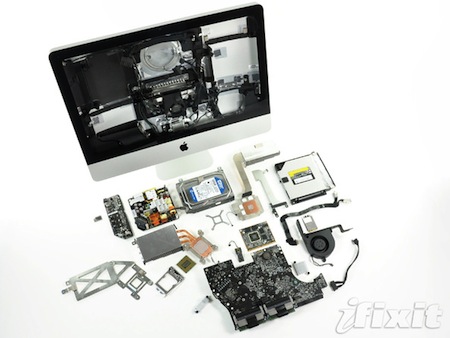
Only couple days ago Apple released new iMacs with Sandy Bridge possessors and Thunderbolt technology. iFixit’s team, of course, immediately started tearing down a 21.5-inch model. They found that this model iMac opens in the same way as previous generations by pulling off the magnetically-held glass and removing the screws holding the LCD in place.
Teardowns Detail Minor Differences Among Wi-Fi, GSM, and CDMA iPad 2 Models

iPad 2 antenna: GSM (top), CDMA (middle), and Wi-Fi (bottom)
iFixit announced that they completed the teardowns of the GSM and CDMA models of iPad 2. Wi-Fi version of the iPad 2 was torn down on launch day. The GSM model has the micro-SIM card slot along the upper left edge to provide the device with subscriber information. On the CDMA version such information stores directly on the WWAN board inside. The CDMA iPad offer slightly different antenna configurations, it has an additional antenna and an integrated GPS receiver. What’s really curious is that the 3G version of iPad 2 has the older Infineon 337Se833 baseband chip rather than a dual-mode Gobi chip found inside the CDMA iPad 2. Maybe it was a supply issue or an engineering decision designed to cut costs a bit.
 Leave a comment, read comments [1]
Leave a comment, read comments [1]
iPad 2 Smart Cover Teardown Reveals 21 Magnets
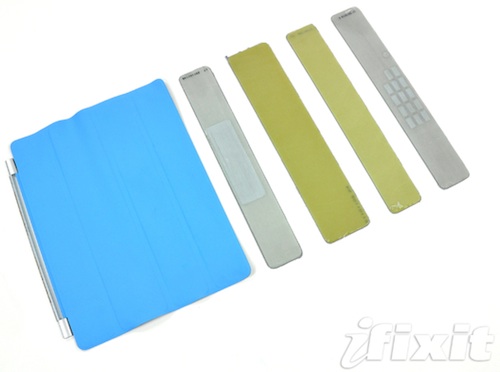
Well-know teardown firm iFixit has recently teardown the Apple’s Smart Cover case for the new iPad 2. The highly publicized case consists of plenty magnets that keep it aligned on the surface of the iPad and turn off and on the device.
There are a total of THIRTY ONE magnets within the iPad 2 and Smart Cover: 10 magnets in the iPad 2, and a whopping 21 magnets inside the Smart Cover. They're the reason why the cover works so well with the iPad 2.
iPad 2 Teardown
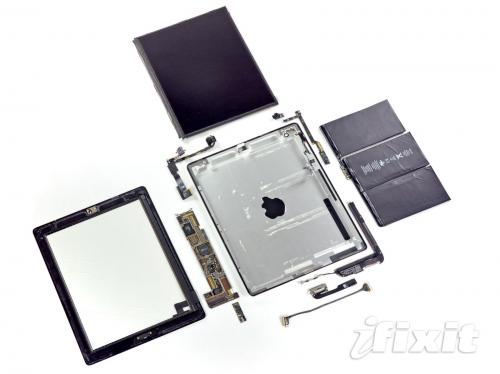
iFixit, as usual, prefers not to waste time and has already teardown newly released iPad 2 16 GB Wi-Fi model. The iPad 2 wasn’t easy to open because of tons of glue (not screws) used to seal it. The iPad 2 is very densely packed and has less empty space inside the body comparing with the original iPad. Here are the initials found inside:
iFixit Verizon iPhone 4 Teardown Reveals GSM Compatible Chip
iFixit tore down the Verizon iPhone 4 and fond out inside a Qualcomm MDM6600 chip that supports HSPA+ data rates of up to 14.4 Mbps, as well as CDMA2000 1xEV-DO Rev. A/Rev. B. The same chipset has the Droid Pro that supports both GSM and CDMA - which means that Apple could support GSM! Apple of course has not included a SIM-card slot in the Verizon iPhone, and thus the device can not actually be used on GSM networks. The use of this particular chip signifies that the iPhone 5 will surely be dual-mode, allowing Apple to ship one handset for both Verizon and AT&T, as well as every other carrier in every other country.
